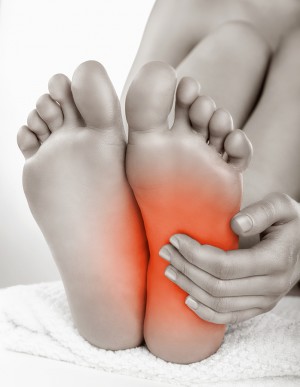 Plantar fasciitis is a painful condition caused by inflammation of the plantar fascia. The plantar fascia is a thick, flat ligament that connects the heel bone to your toes and supports the arch of your foot. When the plantar fascia is strained, small tears can develop, causing it to become weak, swollen and inflamed.
Plantar fasciitis is a painful condition caused by inflammation of the plantar fascia. The plantar fascia is a thick, flat ligament that connects the heel bone to your toes and supports the arch of your foot. When the plantar fascia is strained, small tears can develop, causing it to become weak, swollen and inflamed.
The end result is a sharp, stabbing pain in the bottom of your foot. That’s plantar fasciitis.
Plantar fasciitis is usually most painful after you’ve been sitting, standing or lying down for long periods of time. For example, those first steps when you get out of bed in the morning are a killer. Climbing stairs can also be painful. Once you’ve loosened up your foot, the pain of plantar fasciitis isn’t as intense in most cases.
Although plantar fasciitis is most common in middle-aged people, younger people who spend a lot of time on their feet doing repetitive movements often develop plantar fasciitis. Athletes, especially runners, and even soldiers who spend a lot of time marching are susceptible.
People who place added stress on the plantar fascia because they’re overweight or they don’t wear shoes with adequate arch support are also at a higher risk.
If you feel sharp pain in the heel and bottom of your feet, get it properly diagnosed. Step one is an x-ray, which will tell you if the pain is actually a stress fracture. It’s not uncommon for a stress fracture to be misdiagnosed as plantar fasciitis because no x-ray was taken.
The key to treating plantar fasciitis is inactivity. You have to get off your feet. You shouldn’t be exercising or walking long distances. In severe cases, the foot may have to be booted to eliminate pressure on the plantar fascia.
Ice will help reduce pain and swelling. I always recommend freezing a bottle of water until it’s solid, and then rolling that bottle back and forth under your foot. It’s simple and inexpensive, but every effective.
Physical therapy is often prescribed so a trained professional can guide you through proper stretching exercises, and observe how your heel and toe hit the ground when you walk. Deep tissue massage can also be helpful.
Extracorporeal pulse activation treatment (EPAT) is a newer approach to treatment that delivers pressure waves to stimulate blood circulation and speed healing. Injections are typically a last resort.
From a nutritional perspective, anti-inflammatories like boswellia, onion garlic and rosemary can reduce pain and inflammation. Inflammatone, a natural, non-toxic alternative to anti-inflammatory drugs, uses herbs and enzymes to break down inflammation.
Keep in mind that plantar fasciitis is typically the cumulative effect of straining your foot over a long period of time, so you should expect it to take a while for the pain to completely subside.
It could take months, but you have to stick with your treatment. Otherwise you risk developing more constant, severe pain that hampers your lifestyle for years to come.
Once your plantar fasciitis has been successfully treated, you need to take steps to prevent it from reoccurring. Take better care of your feet. High heels or anything else that puts the foot in a compromised position for a long period of time can lead to plantar fasciitis.
Wear shoes that fit and provide arch support. Get the arches of your feet measured, because it’s not just about flat feet. Plantar fasciitis can be cause by having an arch that’s too deep. If you need an orthotic, get it properly fitted and use it all the time to support your arch.
Just like any other painful condition, don’t try to self-diagnose plantar fasciitis. If you have pain in the bottom of your foot that won’t go away, listen to what your body is telling you. Call a doctor, especially if you notice a fever or develop redness, warmth, numbness or tingling in your heel.
Plantar fasciitis may be a real pain in the foot, but a little knowledge and the right treatment can make it go away and keep it from coming back.